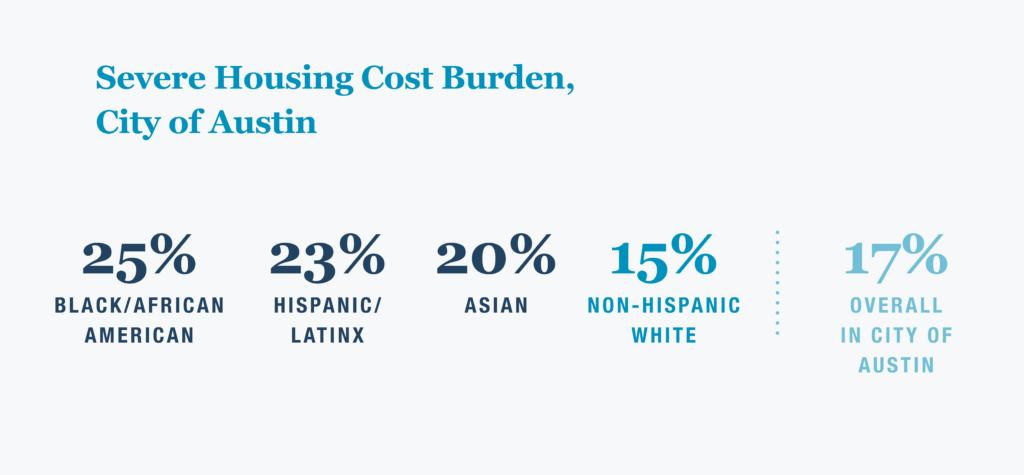Takeaway
The Issue
With the population, cost of living, and cost of housing increasing, Travis County is experiencing strains on the community’s non-medical drivers of health, such as access to healthy food, housing affordability and the financial security required to be healthy.
Due in large part to significant population growth, the high and rising cost of housing disproportionately affects low-income residents, residents of color, older adults, and persons with disabilities displacing residents from urban areas to rural communities. Travis County and Austin experienced population growth of 26% and 20%, respectively from 2010-2020, exceeding the population growth for Texas and the U.S. during the same time period. More than half of the residents (52.2%) identify as people of color, with more than one-third identifying as Hispanic/Latino, 8.2% identifying as Black/African American, and 6.6% as Asian. Nearly one-third of residents in Travis County speak a language other than English at home, underscoring the importance of providing health information and resources in residents’ primary language.
The median household income was $80,726 in 2019 with the median income for White households more than double the median income of Black/African American and Hispanic/Latino households. An estimated one-quarter (25%) of LGBTQIA+ survey respondents reported having incomes less than $24,000 and 13.6% of Travis County children lived in poverty. About 65% of respondents reported spending greater than or equal to 30% of their monthly income on housing and 17% reported spending greater than or equal to 50% of their monthly income on housing – a severe cost burden.

Severe housing cost burden, defined as spending more than 50% of one’s monthly income on rent or mortgage payments, varies greatly by race/ethnicity.
In 2019, 14% of Travis County residents were without health insurance. Participants noted that the high cost of healthcare and insurance prevented the seeking out of services. About 29.6% of Hispanic/Latino survey respondents and 26.7% of White respondents were not able to access dental services. Approximately 25.5% of Black/African American respondents reported being unable to receive medical care and medical prescriptions. Nearly one quarter (24.7%) of Hispanic/Latino respondents listed barriers to accessing vision care.
The Covid-19 pandemic had a substantial impact on the lives and the physical and mental health of residents in Austin/Travis County, exacerbating food insecurity, economic suffering, social isolation, mental health issues, and barriers to accessing information and health care resources for lower-income residents, residents for whom English is not their primary language, and communities of color. Additionally, emergency preparedness was top of mind for many assessment participants, reporting experiencing a natural disaster emergency in the past decade and the personal and community challenges it has caused.
Looking forward: Travis County has many assets, including the strong network of residents and organizations including community health workers, community-based organizations, faith-based organizations, and established community networks that have been meeting the needs of residents most affected by health inequities. Cross-sector partnerships between schools, community-based organizations, private companies, and others are also a community strength and faith-based organizations serve as a bridge between historically marginalized communities and local/county government.
The Findings
Building on the perceived community assets and thinking ahead to the future, participants recommended following suggestions to make Travis County a healthier place:
Long-term health equity planning processes: Creating and deepening relationships through quality outreach with communities across the region and incorporating community leaders from diverse geographic communities and identity-based communities into the planning process, intentionally including long-time residents as well.
Foster collaborations and communication across organizations: Leverage collaborative planning spaces as opportunities to build connections and relationships across local community-based health equity organizations to build collective strategies and action and coordinate efforts.
Funding equity: Shift the funding model to support small community-based organizations and racial equity organizations, re-haul the current reimbursement model to enable the city and county to partner with smaller organizations who have smaller reserves and transparent about how funding priorities are made.
To address the health inequities in the community, it will take community collaboration and systemic changes to processes and funding. Download the report below to learn more about the 2022 community health needs assessment findings for Travis County.